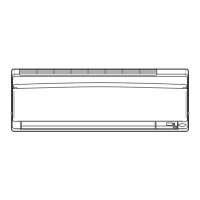What to do if the power cord of Daikin Air conditioning is abnormally hot or damaged?
- Rrhonda65Sep 8, 2025
If the power cord is abnormally hot or damaged, turn the breaker OFF and call the service shop.

What to do if the power cord of Daikin Air conditioning is abnormally hot or damaged?
If the power cord is abnormally hot or damaged, turn the breaker OFF and call the service shop.
Why is my Daikin Air conditioning cooling/heating effect poor?
The cooling or heating effect might be poor due to several reasons. Check if the air filters are clean. Ensure there is nothing blocking the air inlet or outlet of the indoor and outdoor units. Verify that the temperature setting is appropriate. Make sure the windows and doors are closed. Confirm that the airflow rate and direction are set correctly. Also, check if the unit is set to INTELLIGENT EYE mode.
What to do if my Daikin Air conditioning does not operate and the OPERATION lamp is off?
If your Daikin air conditioner isn't operating and the OPERATION lamp is off, check the following: Has a breaker turned OFF or a fuse blown? Is there a power failure? Are batteries properly set in the remote controller? Is the timer setting correct?
What to do if my Daikin FTXS25CVMB8 Air Conditioner heating stops suddenly?
The system is likely removing frost from the outdoor unit. You should wait for about 3 to 8 minutes.
Why does my Daikin FTXS25CVMB8 Air Conditioner smell?
The Daikin Air Conditioner may emit odors because smells from the room, furniture, or cigarettes have been absorbed into the unit and are being discharged with the airflow. It is recommended to have the indoor unit cleaned by a technician. Consult the service shop where you bought the air conditioner.
How to stop the bad odor from my Daikin Air conditioning indoor unit?
If the indoor unit gives out an odor, it is recommended to have the indoor unit washed by a technician. Consult the service shop where you bought the air conditioner.
What to do if an abnormality (such as a burning smell) occurs with Daikin Air conditioning?
If an abnormality, such as a burning smell, occurs, turn the breaker OFF and call the service shop.
What to do if there is a burning smell coming from Daikin Air conditioning?
If you notice a burning smell, immediately turn the breaker OFF and call the service shop.
What to do if I hear an abnormal sound during Daikin Air conditioning operation?
If you hear an abnormal sound during operation, turn the breaker OFF and call the service shop.
Why is my Daikin FTXS25CVMB8 outdoor unit leaking water?
In HEAT mode, the frost on the outdoor unit melts into water or steam during defrost operation. In COOL or DRY mode, moisture in the air condenses into water on the cool surface of the outdoor unit piping and drips.
| Cooling Capacity | 2.5 kW |
|---|---|
| Heating Capacity | 3.2 kW |
| Energy Efficiency Ratio (EER) | 3.21 |
| Seasonal Energy Efficiency Ratio (SEER) | 6.1 |
| Power Supply | 220-240 V, 50 Hz |
| Refrigerant | R32 |
| Weight (Indoor Unit) | 9 kg |
| Weight (Outdoor Unit) | 26 kg |
| Noise Level (Indoor Unit) | 19 dB |
Detailed technical specifications for various components and models of the air conditioner.
Diagrams illustrating connections on printed circuit boards for system diagnostics and repair.
Wiring diagrams for wall-mounted indoor units of the 20/25/35 class.
Wiring diagrams for wall-mounted indoor units of the 50/60/71 class.
Wiring diagrams for duct-connected indoor units.
Wiring diagrams for floor/ceiling suspended dual type indoor units.
Wiring diagrams for floor-standing indoor units.
Wiring diagrams for outdoor units.
Overview of the primary operational functions of the air conditioning system.
Explanation of the inverter's frequency control principle for compressor speed regulation.
Detailed specifications and logic for various control functions within the system.
How compressor frequency is determined and controlled based on various parameters.
Detailed explanation of the electronic expansion valve's control functions in various modes.
Information on detected malfunctions, including sensor and overload issues.
Explanation of forced modes like cooling, heating, and wiring checks for installation.
Procedure for checking and correcting wiring errors using the system's diagnostic function.
Essential safety precautions to be followed during installation, operation, and maintenance.
Guidelines for cleaning the indoor unit, outdoor unit, remote controller, and filters.
Common problems and their solutions, including checks for non-starting, stopping, and abnormal operations.
Important cautions and guidelines to follow before performing any diagnostic procedures.
How to interpret the operation lamp's status for troubleshooting and identifying faults.
Lists common problems with corresponding measures for diagnosis and resolution.
Explanation of how to use the service check function for system diagnostics.
List of error codes displayed on the remote controller and their corresponding problem descriptions.
Detailed error codes displayed on the remote controller and the faults they indicate.
Comprehensive guide to troubleshooting various system malfunctions.
Troubleshooting steps for issues related to indoor units.
Troubleshooting steps for issues related to outdoor units.
Troubleshooting signal transmission errors between indoor and outdoor units.
Diagnosing and addressing OL activation or compressor overload issues.
Troubleshooting compressor lock conditions.
Troubleshooting input over-current detection errors.
Troubleshooting output over-current detection errors.
Diagnosing and resolving issues related to insufficient refrigerant gas.
Step-by-step guide for removing outer panels and components from 80/90 class outdoor units.
Procedure for removing the compressor from the outdoor unit.
Step-by-step guide for removing components from 50-75 class outdoor units.











